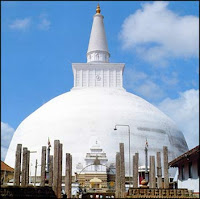 There is trouble in paradise. The Buddhist island nation and former British colony of Sri Lanka ("sacred land"), the teardrop on the tip of India, is still recovering from the longest civil war in Asia when it fought Hindu rebels.
There is trouble in paradise. The Buddhist island nation and former British colony of Sri Lanka ("sacred land"), the teardrop on the tip of India, is still recovering from the longest civil war in Asia when it fought Hindu rebels.It recently settled that decades-old Sinhalese-Tamil dispute with drastic measures and widespread abuses by its democratically-elected government in spite of the president dressing like a king.
 Now that same nominally-Buddhist government is deploying troops against its own farmers who are protesting new governmental regulations.
Now that same nominally-Buddhist government is deploying troops against its own farmers who are protesting new governmental regulations.The capital of Colombo has deployed troops to two towns to control farmers' agitations, explains military spokesman Brigadier Nihal Hapuarachchi.
The military spokesman has told Sri Lanka's national news agency Lankapuvath that a contingent consisting 200 soldiers have been sent to Dambulla (pictured above) and 100 soldiers to Bandarawela.
The troops have been deployed to support the local police to maintain "law and order" in areas where farmers have launched protests against a law that went into effect last month requiring them to transport their fresh produce in plastic or wooden crates.
 Meanwhile, thousands of traders protested the government regulation to transport fruit and vegetables in plastic crates for a third day in downtown Colombo paralyzing business.
Meanwhile, thousands of traders protested the government regulation to transport fruit and vegetables in plastic crates for a third day in downtown Colombo paralyzing business.The traders sat in the middle of the road blocking traffic and creating huge traffic jams. They demanded the government withdraw the new regulation.
The Minister of Internal Trade, however, vowed to uphold it. According to the government, the improper transport of fresh produce has resulted in wastage amounting to billions of rupees. Source
 (Image: Travel-to-Sri-Lanka blog)
(Image: Travel-to-Sri-Lanka blog)
 Sri Lanka, once known as Serendip, is a land of many surprises. Its majority Sinhalese trace their roots and their Buddhism to the "Aryan" Buddhist region of Afghanistan.
Sri Lanka, once known as Serendip, is a land of many surprises. Its majority Sinhalese trace their roots and their Buddhism to the "Aryan" Buddhist region of Afghanistan.Indeed, their tall Buddha statues echo those found in Bamiyan, Afghanistan, possibly in the vicinity of the original Kapilavastu, on the northwestern Indian frontier where Siddhartha grew up.
The island was the source of a strange spice the British could neither get enough nor find the source of -- cinnamon. It has singing fish, massive tea plantations, aborigines (Nagas), surfing, and UFO visitors from Indian mythology, having been the home of child-friendly sci-fi master Arthur C. Clarke.
Most importantly, it is the storehouse of ancient Indian Buddhism preserved in writing on ola palm leaves stored in massive white mound reliquaries. Buddhaghosa, the ultimate Buddhist scholar, commentator, and author of The Path of Purification, came to Sri Lanka from India to recover Buddhist teachings from sources only preserved on the island in ancient times.
In the island's self-serving chronicles (poetic histories), Sri Lankans believe that the Buddha meant for the island to serve as an enduring repository of the Dharma, and their mission as Buddhists continues to be to spread that message. Sinhalese Buddhists in America from Washington DC to Los Angeles are fully enlisted in this belief.
Buddhanet.net
 Sri Lanka is the oldest continually Buddhist country. Theravada Buddhism is the major island tradition since its official introduction in the 2nd Century BC by the enlightened missionary mon Ven. Mahinda, son of the great Indian Buddhist Emperor Ashoka. This took place during the reign of King Devanampiya- Tissa.
Sri Lanka is the oldest continually Buddhist country. Theravada Buddhism is the major island tradition since its official introduction in the 2nd Century BC by the enlightened missionary mon Ven. Mahinda, son of the great Indian Buddhist Emperor Ashoka. This took place during the reign of King Devanampiya- Tissa. Monks from Sri Lanka have had an important role in spreading both Theravada and Mahayana throughout Southeast Asia. In the 1st century AD, during the reign of King Vatta Gamini, Buddhist monastics assembled in Aloka Monastery and wrote down the Tripitaka, the three divisions (baskets) of the Buddha's Teachings, now known as the Pali Canon, for the first time.
Monks from Sri Lanka have had an important role in spreading both Theravada and Mahayana throughout Southeast Asia. In the 1st century AD, during the reign of King Vatta Gamini, Buddhist monastics assembled in Aloka Monastery and wrote down the Tripitaka, the three divisions (baskets) of the Buddha's Teachings, now known as the Pali Canon, for the first time.Wisdom Quarterly
An unintended consequence of invasion and colonization is that invaders take the spiritual traditions they find out into the world:
- the American Empire and Japanese Buddhism (Zen),
- Chinese Empire and Tibetan Buddhism (Vajrayana),
- British Empire and Indian Buddhism,
- Roman Empire and Judeo-Christianity...
 We have Buddhism in excellent English thanks largely to the work of early British and European scholars who translated the ancient texts they found as their empires plundered new lands.
We have Buddhism in excellent English thanks largely to the work of early British and European scholars who translated the ancient texts they found as their empires plundered new lands.This may be how history is meant to be. A famous German Buddhist nun in Sri Lanka, Ayya Khema, wrote a book with an interesting title (When the Iron Eagle Flies: Buddhism for the West). Its title derives from an ancient Tibetan prophesy that Buddhism would reach the outside world when there were planes in the sky ("iron eagles" that could fly).


































































































































































































































No comments:
Post a Comment